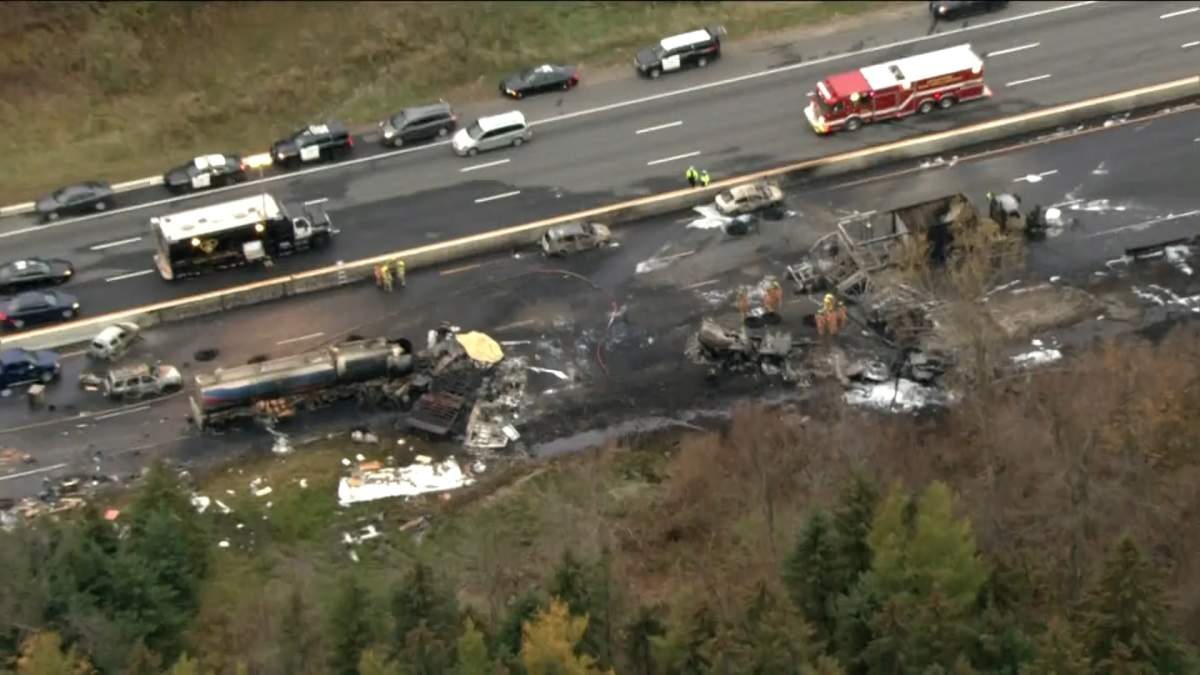TORONTO – As first responders searched for bodies in the wreckage of more than a dozen vehicles involved in a deadly Ontario crash, one expert warned that such traumatic experiences place them at an increased risk of suicide and other mental health crises.

Police openly expressed shock and dismay on Wednesday hours after a 14-vehicle collision on Highway 400 north of Toronto sent fireballs into the sky and rolling down the road.
The crash, which involved two fuel tankers, took place late Tuesday and killed at least three people, leaving charred, twisted debris strewn across the highway.
READ MORE: ‘It is almost Armageddon’: OPP say at least 3 dead after fiery crash on Highway 400
At least one officer on the scene said the carnage was shocking to dozens of first responders who descended on the highway.
One organization offering mental health support to public safety personnel says such situations can trigger powerful, dangerous emotions among a group that’s driven to help save lives, but may feel powerless to do so in situations such as the devastating highway crash.
They say such situations are part of the reason why suicide rates among first responders are anywhere from two to five times higher than the national average.
Vince Savoia of the Tema Conter Memorial Trust said his organization began tracking suicides among paramedics, police, firefighters and military personnel in early 2014. Since then, the numbers have consistently ranged between 20 and 56 per 100,000, well above the national average of about 10 per 100,000, he said. Recently available data from Statistics Canada shows the 2013 national rate was 11.5 per 100,000.
Savoia said events such as the Highway 400 crash can contribute to the mental strain that places first responders at such an elevated risk of self-harm.
Although responders receive training that can help equip them to deal with the grisly sights associated with a major collision, Savoia said the struggle usually originates from a sense of powerlessness in the face of tragedy.

Get daily National news
“If you can imagine a first responder who is driven to help and to provide that aid immediately, arriving upon a scene like this … the first responders were unable to do their job in saving life,” he said. “That in itself may cause a sense of guilt in some first responders who may suffer with the helplessness and hopelessness of not being able to assist those who require the help.”
Much of Wednesday’s efforts from first responders were indeed focused on recovery rather than rescue.
VIDEO: OPP Commissioner Vince Hawkes says he’s been moved by the stories of previous victims of crashes and the OPP is constantly looking at ways for prevention.

Ontario Provincial Police Sgt. Kerry Schmidt said first responders were combing the scene with dogs in tow searching for victims who were either ejected from their vehicles or burned as they tried to flee the scene.
Sounding shaken at times as he described the scene, which he characterized as one of “carnage” and “horror,” Schmidt detailed a scenario that could have both short and long-term impacts on those who witnessed it.
“We were a thousand metres up the road dealing with another collision when this collision occurred. We saw and heard and felt the heat and the collision and the fire as it exploded behind us,” he said. “Emergency responders were running into the fire to see what they could do to save people that were involved.”
Savoia said incidents like Tuesday’s crash highlight the ongoing need for more mental health supports for people working in the public safety field.
“It’s one thing to raise awareness and encourage people to come forward, but the reality is, where do they go afterwards?”
Savoia said a key step involves encouraging organizations to develop peer support programs that include those trained in crisis intervention and armed with information to refer their colleagues to the right avenues for long-term help.





























Comments